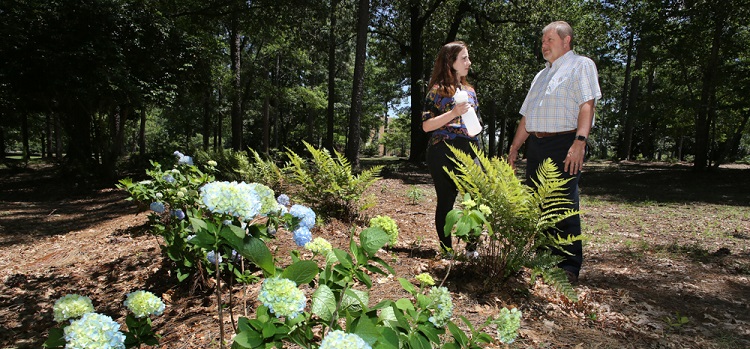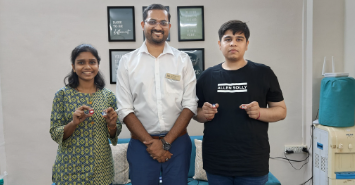Erosion: Keeping a LID on It
Posted on May 20, 2019 by Bob Lowry

It’s pretty well known that Mobile receives the most annual rainfall of any major city in the United States, more than 60 inches a year. It’s also well known – at least, locally – that when it rains, it often pours. So, when it rains in Mobile, storm water runoff is a frequent occurrence.
The wooded, tranquil campus of the University of South Alabama is a case in point. USA is located within the Three Mile Creek watershed. Three Mile Creek stretches from west of the University, through Langan Park, and into the Mobile River and Mobile Bay. Immediately to the north of the campus lies a wetlands area that is, in fact, part of the headwater region of Three Mile Creek. Most storm water runoff from the USA campus flows directly into this area of the creek through drainage inlets and underground pipes all over campus.
But it’s not just storm water that makes its way to Three Mile Creek. Soil is often
eroded by the storm water runoff from unvegetated areas, and eventually that soil
also finds its way into the creek. And therein lies the problem in search of a solution.
Enter USA’s College of Engineering. Dr. Kevin White, P.E., professor and chair of the department of civil, coastal and environmental engineering, is working with the Alabama Department of Environmental Management, or ADEM, on
a storm water management project right on campus. It’s part of the Three Mile Creek
restoration initiative headed by the Mobile Bay National Estuary Program, or NEP,
and the city of Mobile. The NEP watershed management plan has identified USA as a
contributor of sediment to Three Mile Creek, and White has identified bioinfiltration
swales as a solution. First, though, some background.
Currently, according to White, storm water management is usually achieved through three basic practices. One is the curb and gutter. It’s very popular, especially in residential and business developments, and fairly efficient in capturing and transporting “every drop” (says White) of storm water from hardened surfaces such as parking lots.
A second practice is the use of large, open, drainage ways, usually a concrete ditch. Scattered throughout Mobile, these efficiently transport very large amounts of storm water into creeks, rivers and eventually, Mobile Bay.
The third practice is runoff detention/retention. These are pond-like facilities that collect and hold storm water runoff from commercial properties and suburban neighborhoods to help minimize flooding downstream.
All three practices have their positive points, but White believes there’s a better way, by actually minimizing storm water runoff through the use of bioinfiltration swales. “We call them low-impact development, or LID, for short. LID utilizes ‘natural’ solutions, such as vegetation and infiltration, instead of the traditional ‘hardened’ solutions that use concrete and steel,” White explained.
“LID is modeled after nature, designed to manage rainfall at the source using micro-scale controls that mimic a site's predevelopment hydrology,” White elaborated. “LID uses techniques that infiltrate, filter, store, evaporate and detain runoff close to its source. Instead of conveying and managing large volumes of storm water, LID addresses it through small, cost-effective landscape features located at the lot level.”
“LID is modeled after nature, designed to manage rainfall at the source. Instead of conveying and managing large volumes of storm water, LID addresses it through small, cost-effective landscape features located at the lot level.”
In case you’re thinking this is just a laboratory theory, the concept is already being put into practice on the USA campus. With funds from ADEM and the University, five landscaped bioinfiltration swales have been installed between the Whiddon Administration Building and Meisler Hall.
“They are helping to capture storm water runoff and soak it into the ground, instead of running off on the surface and eroding soil that eventually deposited into Three Mile Creek,” White said, adding that sampling indicates a 78 percent sediment concentration reduction is taking place.
Jordan Blackmon, a sophomore civil engineering major from Mobile, has been doing the monitoring on the Meisler project. “My procedures included collecting sample bottles from the Meisler commons area, filtering the water to find the total suspended solids, and calculating the downhill reduction rates,” Blackmon said. “I also compared these results to different models to make sure they were working efficiently.”
For Blackmon, there’s an additional benefit to helping clean up Three Mile Creek. “I definitely see how this project will fit into my career. Exposure to specific water management techniques broadens my interests and experience, and seeing real engineering work and how it is helping our community is inspiring and reminds me why I’m in school getting this degree.” Blackmon this summer will work as an environmental intern at Chevron’s facility in Pascagoula, Miss.
A second ADEM/USA-funded project for storm water management on campus will remove the existing curbs around the parking islands in the large Humanities Building parking lot. This project will begin this month and will be finished before fall classes start.
“We will rebuild and landscape the parking lot islands so they accept storm water runoff and infiltrate much of it into the ground,” White said. “This will lessen the amount of water that gets discharged to the gully just west of the Student Center and the Marx Library, which in turn will lessen the erosion that is occurring in the gully and eventually gets deposited into Three Mile Creek.”
The islands are roughly 200 feet long and 10 feet wide. The bioinfiltration areas inside each island will be about eight feet across and two feet deep. The bottom layer of these infiltration areas will consist of large stone, which is underneath a foot of coarse sand and compost, and topped with more stone and plants. Easy on the eyes and the environment, but tough on storm water runoff and sediment.
As a backup and a concession to the extreme downpour, each island will also have an overflow structure connected to an existing storm drain.
“This project, like many that we do as civil engineers, uses new and better techniques to solve large-scale problems in the areas where we live and work,” White said. “It’s very fulfilling to build something that is effective at reducing storm water runoff and soil erosion, but is also nice to look at. And it’s a small part of a much larger effort to clean up and restore Three Mile Creek into something we can all be proud of.”
 Jordan Blackmon, sophomore civil engineering major,
Jordan Blackmon, sophomore civil engineering major,
holds the type of bottle she uses to sample runoff.
-

Dr. Woods and Dr. Wu honored by MACE awards
This year, two prominent faculty from the College of Engineering are r...
March 3, 2025 -

Launching a Career
Launching a Career...
August 8, 2024 -

USA Engineering Professor Receives New NSF Grant for Novel AI Computing Systems
A new $275,000 project entitled "Carbohydrate Memristor Empowered...
August 13, 2024 -

South Launches New Faculty Ambassador Program
South Launches New Faculty Ambassador Program...
July 30, 2024


